VuFind usage fives times that of "classic catalogue"
I work at the York University library. In January we launched VuFind as our discovery layer, bringing together four or five silos of information into one place. We relegated the SirsiDynix WebCat OPAC to the classic catalogue.
In the spring I used compared usage of the old and new systems, and I was very surprised to find they were running about equal. Looking at how the usage has gone the rest of the year shows that since September VuFind is getting five times the usage of the classic catalogue.
(Note: the dead spot in March/April is where I misconfigured Google Analytics and lost a month! Sorry about the width of the images. I need to change my template.)
Here’s the usage of the classic catalogue. It peaks at under 10,000 page views per day. The peaks are all on Mondays, which is the busiest day of the week on our web site. Usage declines until Saturday, then picks up again on Sunday.

And VuFind, peaking at around 50,000 page views per day:
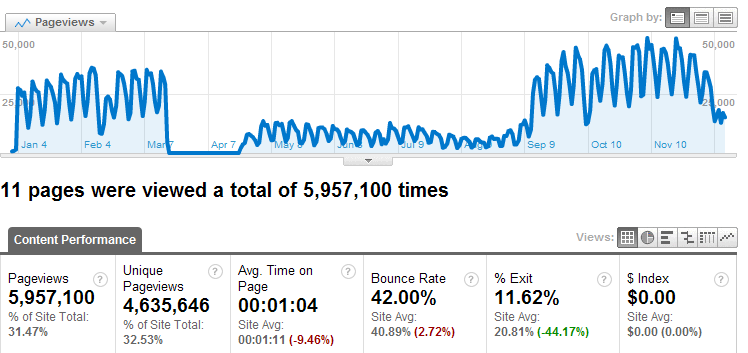
VuFind’s search results listings are much, much richer than the classic catalogue’s. They tell you pretty much everything you need to know about items, and I think in many cases people will look no further. In the classic catalogue the search results hardly have any information and you always need to look at the item records. For that reason, I think that comparative usage of VuFind is even higher, because one page view there counts for ten in the old system.
According to Google Analytics, people average about 60 seconds looking at the search results pages in VuFind, and 90 seconds looking at item records. In the classic catalogue, they spend about 45 seconds per page average, but I can’t break it down by type of page.
Nuit Blanche 2010
This year Nuit Blanche began in Toronto at sunset on 2 October and continued through the night to dawn on 3 October. There were art exhibits, installations, and events open all over downtown.
My two favourites were Reunion, staged in the Ryerson University Theatre, and Eric Satie’s Vexations (1893) in Brookfield Place.
“Reunion” is built around a famous chess game played at Ryerson in 1968 between Marcel Duchamp and John Cage. Here’s the description of “Reunion,” copied from the Nuit Blanche web site, which doesn’t have archives:
Reunion, 2010
Group Exhibition
Performance Art
In 1968, a Festival of Art and Technology titled Sightsoundsystems was directed by Udo Kasemets and jointly presented by the Isaacs Gallery and Ryerson Polytechnical Institute. The festival was launched with a collaborative performance titled Reunion held at the Ryerson Theatre on the evening of Tuesday 5 March and featuring John Cage, Marcel Duchamp, and Teeny Duchamp, with electronic music by David Behrman, Gordon Mumma, David Tudor, and Lowell Cross. In the performance, games of chess determined the form and acoustical ambience of the event. A sound-distributing chessboard designed and built by Lowell Cross created sound in response to the various moves made by the players (a series of photoelectric cells underneath each square of the chessboard were used as triggers). Except for a brief curtain call in Buffalo, NY five days later, Duchamp made his last public stage appearance in Reunion on the Ryerson Theatre stage.
Reunion 2010 invites a number of local and international participants influenced by the twin legacies of Cage and Duchamp to create a new 12-hour performance for the same stage. The event celebrates this historic artistic convergence that is both a local piece of Toronto lore as well as an art historical event of international consequence.
Events went on all night. I saw one part of it.
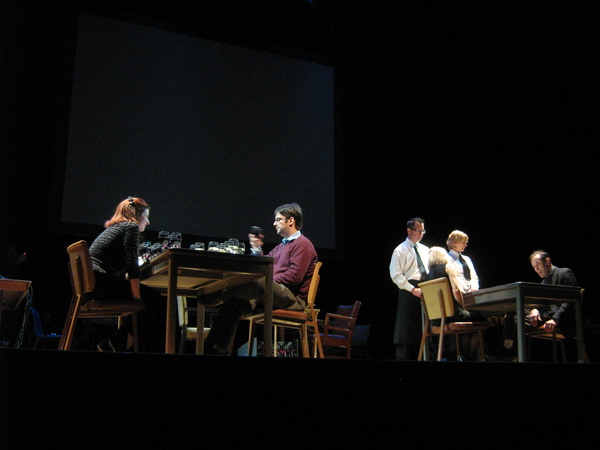
In this picture, on the left Jennifer Shahade and Pascal Charbonneau are performing “Wine Chess” by Takako Saito. All of her pieces were glasses of red wine, and his pieces were white wine. They could tell them apart only by the bouquet and taste. (And, to be sure, their memories, because chess players that good don’t need the pieces.)
On the right, performing Saito’s “Canape Chess,” are William Anastasi and Dove Bradshaw. Their chessboard began with no pieces. When they moved a piece for the first time, a canape would be put down to represent it. When the piece was taken, the canape could be eaten. Behind them, a musician played a prepared harp.
I sat watching “Reunion” for about half an hour, starting around midnight. This is what it sounded like (8.3 MB MP3).
Around 1:30 AM I went to Erik Satie’s Vexations (1893), by Micah Lexier and Martin Arnold:
Erik Satie’s Vexations (1893), 2010
Martin Arnold - Toronto, Canada
Micah Lexier - Toronto, CanadaTwo Pianos, Table, 840 sheets of paper (folded)
Written in 1893, Erik Satie’s Vexations was never published nor publicly heard during his lifetime. He left 39 beats of hand scrawled, insidiously vexing music—hard to read and hard to remember—and the following cryptic instruction: “to repeat 840 times this motif, it is advisable to prepare oneself in the most absolute silence, by some serious immobilities.” A number of performers (most notably John Cage) have ventured to take him at his word and successively play the piece 840 times, taking between 15 and 27 hours to do so. We only have 12 hours so we’re dividing it: two pianos playing simultaneously, 420 passes per piano. Our Vexations is staged in the majestic arched expanse of a cathedral of commerce, perhaps therefore taking part in a highly irregular sort of exchange. We’ll be counting; tonight, by playing 840 scores—each a vexation—once. After each score is played it is transformed into a folded paper sculpture—840 scores creating 840 objects—giving shape to the sound and echoing the team of pianists weaving the composition’s unmonumental but resolutely vexing notes. Satie said: “Before I compose a piece, I walk around it several times, accompanied by myself.” We invite you to walk around Vexations, hopefully several times as it accumulates through the night.
Martin Arnold and Micah Lexier are both based in Toronto. Arnold’s compositions are performed nationally and internationally. Lexier is a visual artist, a collector, and (sometimes) a curator. Arnold is active in Toronto’s improvisation and experimental jazz/roots/rock communities performing on live electronics, banjo, melodica, and hurdy-gurdy. Lexier has a deep interest in measurement, numbers and the kinds of marks we make in our day-to-day lives. Arnold teaches at Trent University. Together their ages equal 99 years.
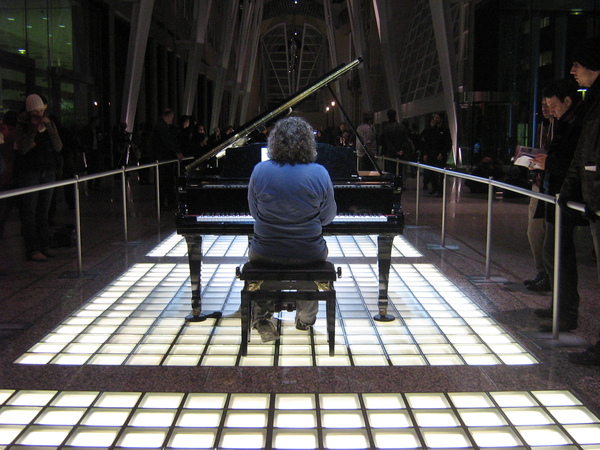
That’s one of the two pianists performing “Vexations” when I was there. I stood by her for a while, then moved into the middle of the long space between the two.
This is what it sounded like (9.0 MB MP3).
A little ways away two people folded the scores that had been played and set them out on a very long table.
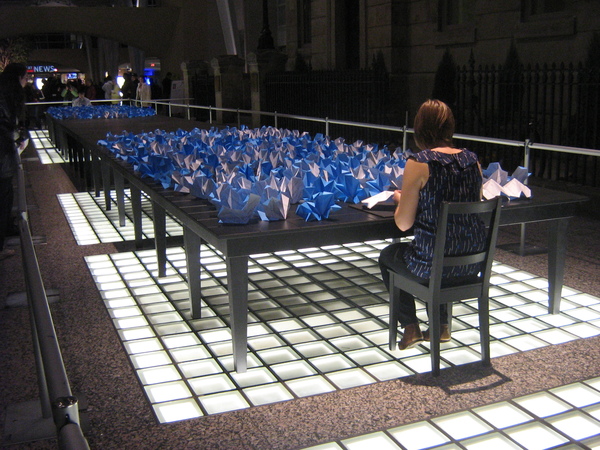
Both pieces were beautiful.
After Launching Search and Discovery, Who Is Mission Control?
Last Friday, 15 October 2010, Adam Taves and I gave a talk called “After Launching Search and Discovery, Who Is Mission Control?” at Access in Winnipeg. Here’s the abstract:
Reference librarians are whiny and demanding.
Systems librarians are arrogant and rude.
Users are clueless and uninformed.
A new discovery layer means that they need to collaborate to build it and then — the next step — integrate it into teaching and learning. How should we (reference librarians, systems people, and users) work together to better exploit the possibilities of open source systems so we can focus on discovery and understanding instead of the mechanics of searching?
The talk turned into a play, and we gave it a subtitle: “A Tragicomedy in 8 or 9 Acts.” We performed a staged reading. I recorded it, and the audio and assorted other files are online:
- Audio of the talk (15 MB MP3)
- The script (250 KB PDF)
- PowerPoint slides, which are missing the embedded audio and video (1.3 MB PPT)
- Quicktime movie of the slides, including the audio and video, played through without stops (68 MB MOV)
I recommend listening to the MP3, and then watching the Quicktime movie if you want more.
Adam (who played “Adam”, while I played “Bill”) managed the multimedia, and embedded into the slides video clips from librarians Cameron Hoffman (Concordia), Sheril Hook (University of Toronto Mississauga), and Caroline Stewart (University of Guelph-Humber), plus an audio clip of Seymour Lubetzky and a voiceover by Adam himself. Because these were all external files, they’re not in the PowerPoint slides. If you watch the Quicktime movie you’ll see them all (including closed captions on the video clips, which make it clear what the people are saying) but there are no slide breaks.
I had a good time at Access, as always. There were good talks, and I enjoyed seeing old friends and meeting some new people. The Hackfest was very productive and I’ll post about that next!
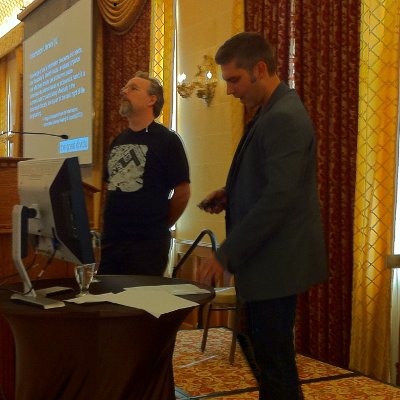
Hackfest project: nlpltc
I put in a suggestion for the Hackfest before the Access 2010 conference in Winnipeg, MB:
It’s possible to export from LibraryThing in custom spreadsheet formats — but what if you want a nice-looking printed catalogue for a small special library? Use OpenOffice.org or LaTeX, with a scripting language, to generate an attractive printed catalogue.
(I was wrong about the custom spreadsheet exports: they’re not possible. You can get an export in comma-separated or Excel formats.)
And that’s the one I worked on, with fellow librarians Ganga Dakshinamurti (University of Manitoba), Wendy Huot (Queen’s University), and Rebecca Larocque (North Bay Public Library).
Wendy and Rebecca did slides for the Hackfest report that explain everything, and I’ll link to them when I can.
Briefly, though, Wendy and Ganga spent the morning thinking about features, requirements, who might use a thing like this, what we needed to know, and so on. I got started hacking together some Ruby and LaTeX. Rebecca took the other route and started working with OpenOffice.org. She’d worked with Microsoft Office before to take data from a spreadsheet and run it through a form to do a sort of mail merge thing, and this was the same sort of idea, though OpenOffice works a bit differently.
By the afternoon I had a basic script working and started refining it. Wendy found some beautiful examples of old printed catalogues and drew up a design of what ours should look like, but my LaTeX-fu wasn’t good enough. Rebecca made steady progress through the day on OpenOffice, running into this problem and then fixing it, then that unknown and figuring it out, and by the late afternoon she could generate a printed catalogue too — except each item would appear on its own page! We were using her LibraryThing collection as test data, and because she has 420 books there her printed catalogue would be 420 pages.
Scott Phillips has a new book: Rut
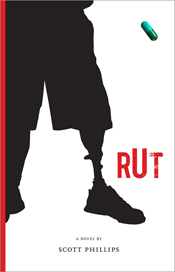
Scott Phillips is a very good writer. He did The Ice Harvest (2000), an amazing noir novel that all takes place over one night in Wichita on Christmas Eve in 1979. The Walkaway (2002) was connected, but different, it was a prequel and a sequel, longer and expansive. Then Cottonwood (2003) was very different: a noir, horror western with a family of serial killers.
On 22 October, Rut is coming out from Concord Free Press. The blurb says:
[It] takes readers to the Rocky Mountains circa 2050, where the once thriving burg of Gower is about to become a 21st-century ghost town. Thanks to extreme weather and plenty of toxic waste, the skiers and celebrities are gone, along with the money and the veneer of civilization. What’s left? Old-time religion and brand-new pharmaceuticals, bad food and warm beer, mutated animals and small-town gossip. Can the town survive? We’ll see.
I’d never heard of Concord Free Press before. It’s free as in speech, but also free as in beer: they give their novels away for free, but you can donate money to them. Surprising! I’ve never heard of a publisher working like this.
Scott Phillips is one of those writers that the fiction publishing industry doesn’t support any more. I don’t know why it’s been seven years since his last novel, but I’m glad he has another one coming out. I’ll order it the day it’s available, and I’ll donate a fair amount to Concord. I hope he and they do well.
I know nothing about this book beyond what’s on Concord’s web site, but based on his last three books, if you like noir, and if you like SF, this one is worth investigating. I’ll report back after I’ve read it.
After Launching Search and Discovery, Who Is Mission Control?
On Friday 15 October 2010, at the Access 2010 conference about libraries and technology, my York University colleague Adam Taves and I are giving a talk called “After Launching Search and Discovery, Who Is Mission Control?”
Reference librarians are whiny and demanding.
Systems librarians are arrogant and rude.
Users are clueless and uninformed.
A new discovery layer means that they need to collaborate to build it and then — the next step — integrate it into teaching and learning. How should we (reference librarians, systems people, and users) work together to better exploit the possibilities of open source systems so we can focus on discovery and understanding instead of the mechanics of searching?
We’d love to hear any thoughts you have about this. At WILU 2010 (WILU being the major Canadian conference on libraries and information literacy), Adam asked some people these three questions:
- What do you want from a search and discovery layer?
- What do you want from your systems people?
- What should they want from you?
What are your answers? Leave a comment, send me email, say something to me on Identi.ca or on Twitter, or if you see this mentioned on a mailing list, follow up there. Have you been through this process before? Been on the IT side, and had to put up with whiny and demanding librarians? Been on the public services side, and had to put up with rude and arrogant developers? Been a user who isn’t actually clueless and uninformed?
(Mita Williams posted about this in June: Information tool literacy. Thanks, Mita.)
Review of Implementing FRBR in Libraries, by Zhang and Salaba
My review of Implementing FRBR in Libraries: Key Issues and Future Directions, by Yin Zhang and Athena Salaba, will appear in Cataloging & Classification Quarterly 49 (1) in January 2011. It’s published by Neal-Schuman and they have a page up about it. See also FRBR-Based Systems to Effectively Support User Tasks and Facilitate Information Seeking, the project out of which this book grew.
(C&CQ is published by Taylor & Francis, and SHERPA/RoMEO says they allow preprints to be archived by the author, so I’m able to put it up for public access. My thanks to C&CQ and Jane Schmidt, the book review editor.)
How I recovered a lost partition
Last week I was setting up a bunch of drives for a new backup system (which I’ll post about soon) and while partitioning and formatting I accidentally removed the single partition from my main laptop. That was not good. I knew it would keep on working as long as it stayed on, but when it rebooted, I’d be in trouble. I had backups, and if it came to the worst, I could reinstall Ubuntu and copy my files back, but that would take an evening, after all the various programs and packages I use had downloaded and installed.
With a bit of luck, though, it only took about twenty minutes.
- I booted up into Ubuntu on a USB stick.
- I installed TestDisk and used this step-by-step guide to recover my lost partition.
- I rebooted. The partition was there, but the computer didn’t know how to boot.
- So I reinstalled GRUB. I can’t find the actual page I used with the commands, but my drive was /dev/sda, the partition I’d recovered was /dev/sda1, and I did this:
-
sudo mount /mnt /dev/sda1 -
sudo grub-install --mount-directory /mnt /dev/sda(note/dev/sdahere, even though I mounted/dev/sda1) -
sudo umount /mnt
-
- I rebooted, and it came up fine, but with a warning about a missing disk. I’d lost my swap space.
- I used gparted to allocate swap space out of some empty disk space that probably was swap space before but got lost along the way. I had to edit
/etc/fstabto say that/dev/sda2was swap space now. - Rebooted and all was well.
Phew! TestDisk is extremely helpful.
 Miskatonic University Press
Miskatonic University Press